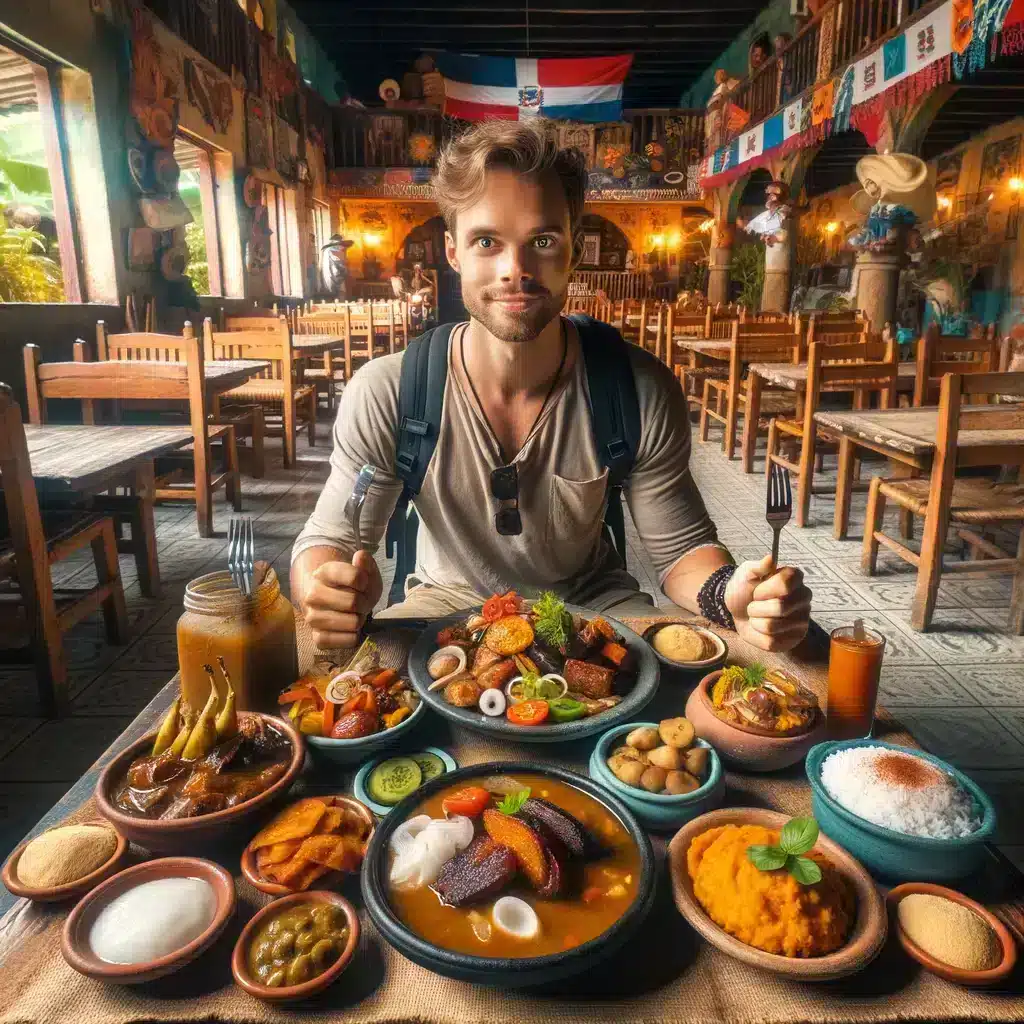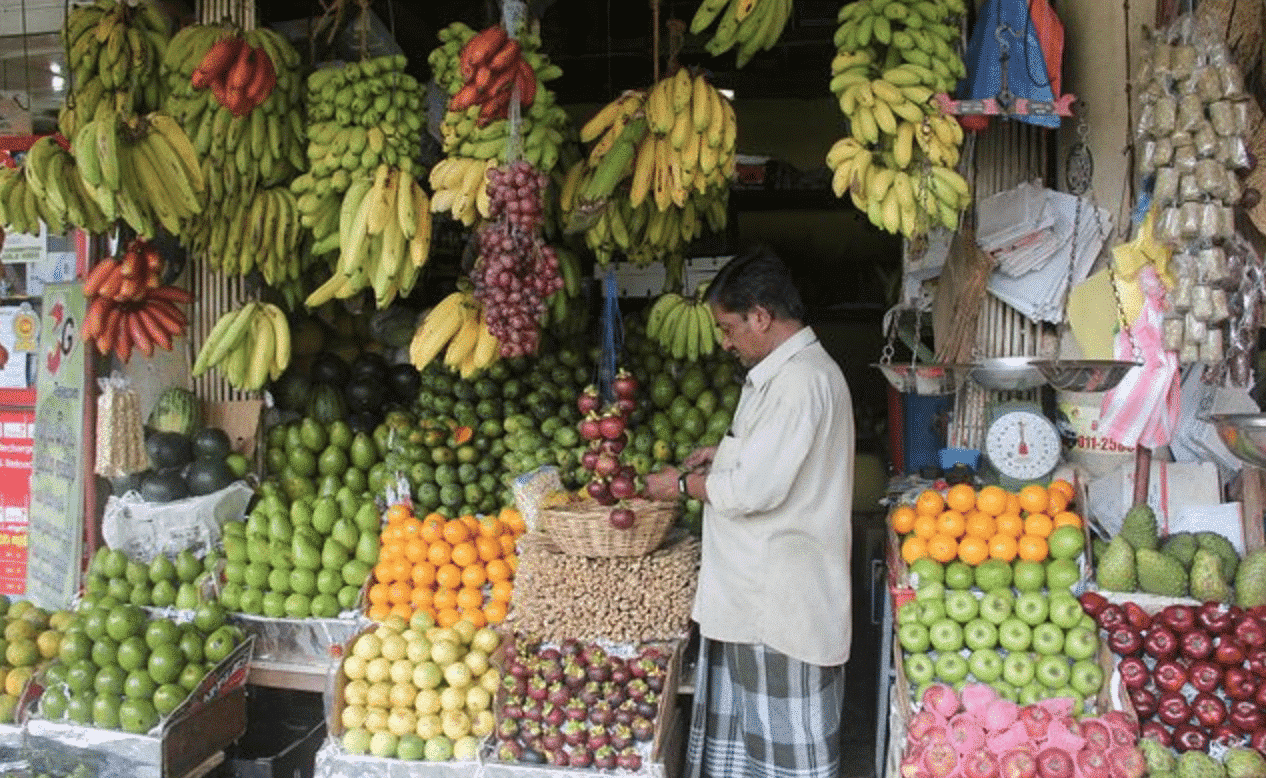Introduction to Dominican Cuisine: A Flavorful Journey
As you embark on your Dominican Republic adventure, one of the most enticing aspects of this captivating nation is its vibrant and diverse culinary landscape. In this introduction, we will provide you with a general overview of Dominican cuisine, shedding light on the significance of gastronomy in Dominican culture. Prepare to be tantalized by the flavors and traditions that make Dominican food a culinary delight. A Tapestry of Flavors: Dominican Gastronomy Unveiled : Dominican cuisine is a delightful fusion of flavors influenced by the nation’s rich history and multicultural heritage. This tapestry of tastes draws from a harmonious blend of African, Spanish, and indigenous Taíno influences. It’s a cuisine that reflects the country’s tropical climate, lush landscapes, and the bounty of both the land and sea. From the savory notes of slow-cooked stews to the sweet indulgence of tropical fruits, Dominican cuisine offers a diverse array of dishes that cater to all palates. Whether you are a fan of seafood, a lover of hearty meats, or a vegetarian seeking flavorful options, there’s something for everyone on the Dominican menu. Cultural Significance: Food as a Reflection of Identity . In the Dominican Republic, food is not merely sustenance; it is a reflection of identity and an expression of culture. The act of preparing and sharing meals is a cornerstone of Dominican social life. It is a way for families and communities to come together, celebrate, and pass down traditions from one generation to the next. You’ll find that many Dominican celebrations, from birthdays to holidays, are marked by feasts featuring traditional dishes that hold a special place in the hearts of the people. These gatherings are a testament to the warmth and hospitality of the Dominican people, who eagerly share their culinary heritage with visitors. In this culinary journey through the Dominican Republic, we will explore the signature dishes, local ingredients, and cultural nuances that define this extraordinary gastronomic experience. Get ready to savor the flavors of a nation where every meal is a celebration of life and a testament to the fusion of cultures that have shaped its remarkable culinary identity.
Traditional Delights: Must-Try Dominican Dishes

As you plan your journey to the Dominican Republic with the convenience of e-ticket services, one of the most exciting aspects is the opportunity to savor the country’s iconic and mouthwatering dishes. Dominican cuisine is a captivating blend of flavors, and these traditional dishes offer a rich taste of the nation’s culinary heritage. Let’s delve into some of the must-try Dominican classics, each a masterpiece in its own right.
1. La Bandera – The Dominican Flag Dish: ??
- A Taste of National Pride: La Bandera, which translates to “The Flag,” is a symbolic representation of Dominican culture and identity. It consists of a hearty trio: white rice, red beans, and stewed meat (usually chicken, beef, or pork). These ingredients symbolize the colors of the Dominican flag. It’s a dish that unites Dominicans and embodies the spirit of their nation.
- Ingredients: White rice, red kidney beans, and your choice of stewed meat.
- Preparation: The beans are slow-cooked to perfection with a blend of spices, while the meat is tenderly stewed. Served with a side of rice, it’s a wholesome and flavorful meal that’s both comforting and filling.
2. Mangú – Mashed Plantains: ?
- A Breakfast Delight: Mangú is a beloved Dominican breakfast staple. Ripe green plantains are peeled, boiled, and then mashed to create a smooth and creamy consistency. It’s often accompanied by pickled red onions (cebolla) and served with eggs, salami, and cheese.
- Ingredients: Green plantains, red onions (cebolla), eggs, salami, and cheese.
- Preparation: The plantains are boiled until soft, mashed, and then served hot. The pickled onions add a tangy contrast to the mild sweetness of the mangú.
3. Sancocho – Hearty Stew: ?
- A Comforting Classic: Sancocho is a hearty and flavorful stew that has earned its place as a Dominican comfort food. This dish is made by slow-cooking a medley of meats (chicken, pork, beef) with various root vegetables like yam, cassava, and plantains. It’s seasoned with a blend of aromatic herbs and spices, resulting in a rich and satisfying meal.
- Ingredients: A variety of meats, root vegetables, herbs, and spices.
- Preparation: The meats and vegetables are simmered together to create a flavorful broth, and the dish is typically served with a side of white rice.
4. Chicharrón – Crispy Pork: ?
- A Savory Snack: Chicharrón is the Dominican take on crispy fried pork, and it’s a favorite snack or side dish. Pieces of pork belly or pork rind are deep-fried until they achieve a delightful crunch. It’s often seasoned with garlic and served with yuca (cassava) or tostones (fried green plantains).
- Ingredients: Pork belly or pork rind, garlic, and seasonings.
- Preparation: The pork is deep-fried until golden brown and crispy, creating a mouthwatering treat with an irresistible texture.
These traditional Dominican dishes are culinary gems that capture the essence of the country’s vibrant culture and flavors. When using e-ticket services to organize your trip to the Dominican Republic, be sure to include tasting these iconic dishes on your itinerary. Each bite will be a journey through the rich history and diverse influences that have shaped Dominican cuisine.
Flavors and Influences: A Culinary Fusion in Dominican Cuisine
As you embark on your culinary exploration of the Dominican Republic, it’s essential to understand the unique blend of flavors and influences that make Dominican cuisine a true cultural masterpiece. This Caribbean nation’s culinary identity is a fascinating fusion of African, Spanish, and indigenous Taíno elements, resulting in a symphony of tastes that is both familiar and distinctly Dominican.
Cultural Tapestry of Flavors: ?
The origins of Dominican cuisine are deeply rooted in its history. The Spanish conquistadors brought with them ingredients and cooking techniques from Europe, such as garlic, onions, and olive oil. These elements intertwined with the culinary traditions of the Taíno indigenous people, who contributed ingredients like cassava, sweet potatoes, and peppers. African slaves, brought to the island during colonization, introduced flavors and cooking methods that have left an indelible mark on Dominican cooking, including the use of plantains, yams, and tropical fruits.
The result is a vibrant and harmonious mix of ingredients, seasonings, and cooking styles that reflect the nation’s multicultural heritage. Each bite of Dominican cuisine is a testament to the diverse influences that have shaped this captivating culinary landscape.
Tropical Bounty: ?
One of the standout features of Dominican cuisine is its abundant use of tropical ingredients. The Dominican Republic’s tropical climate and fertile lands provide an array of fresh and exotic produce that infuses dishes with vibrant flavors. Some tropical ingredients that take center stage in Dominican cooking include:
- Plantains (Plátanos): These starchy, banana-like fruits are used in countless Dominican dishes. They can be fried, boiled, mashed, or even made into tostones (twice-fried green plantains) for a crispy side dish.
- Yuca (Cassava): A root vegetable, yuca is used to make cassava bread, yuca con mojo (yuca with garlic sauce), and more.
- Coconut (Coco): Coconut milk, coconut oil, and shredded coconut are staples in Dominican cuisine, adding a rich and tropical flair to many dishes. You’ll find coconut in both savory and sweet creations.
- Tropical Fruits: Dominican cuisine celebrates an abundance of tropical fruits, including guava, mango, pineapple, and passion fruit, which are used in desserts, beverages, and salsas.
Exploring the culinary tapestry of the Dominican Republic is like taking a journey through time and across continents, with each dish offering a taste of history and tradition. As you plan your trip using e-ticket services, prepare your palate for a delightful fusion of flavors that reflect the nation’s rich heritage and the lush tropical bounty of this Caribbean paradise.
Coastal Delights: Culinary Treasures of the Coast
As you explore the culinary landscape of the Dominican Republic with the convenience of e-ticket services, be sure to set your sights on the country’s coastal regions. These areas are brimming with delectable specialties that highlight the bounty of the Caribbean Sea, including fresh seafood, fish, and rice-based dishes. Let’s dive into the coastal culinary experiences that await you along the shores of this beautiful nation.
A Bounty from the Sea: ?
The Dominican Republic’s coastline stretches for hundreds of miles along both the Atlantic Ocean and the Caribbean Sea, making it a seafood lover’s paradise. Coastal communities have long depended on the ocean’s abundance for their sustenance, and their culinary traditions are steeped in the flavors of the sea.
Fresh Catch of the Day: ?

One of the joys of dining on the coast is the opportunity to savor the catch of the day, brought in fresh from the ocean. You’ll find a variety of seafood and fish prepared in various ways, from grilling to frying to stewing. Popular options include:
- Pescado Frito: Crispy fried fish served with a side of tostones (fried green plantains) and a dash of lime.
- Mariscada: A flavorful seafood stew made with a medley of shellfish, including shrimp, crab, and lobster, simmered in a savory tomato-based broth.
- Ceviche: A refreshing dish made with fresh raw fish or seafood marinated in citrus juices, often with onions, peppers, and cilantro.
Rice-Based Delights: ?
Rice is a staple in Dominican coastal cuisine, often forming the base of many dishes. One such dish is “arroz con coco” (coconut rice), where rice is cooked in coconut milk, infusing it with a tropical, creamy flavor. It pairs perfectly with seafood, creating a harmonious blend of land and sea.
For a true taste of coastal culture, consider visiting local seafood shacks and beachfront restaurants. Here, you can relish the ocean breeze while indulging in the freshest catches and rice-based creations. Don’t forget to accompany your meal with a cold beverage or a tropical fruit juice for the full coastal experience.
As you savor the coastal delights of the Dominican Republic, you’ll not only delight in the flavors of the sea but also immerse yourself in the vibrant culture of the coastal communities. The convenience of e-ticket services allows you to seamlessly plan your coastal culinary adventure and relish the ocean’s bounty while enjoying the picturesque surroundings of this Caribbean gem.
Desserts and Refreshments: Sweet Temptations of the Dominican Republic
In your quest to explore the culinary treasures of the Dominican Republic using the convenience of e-ticket services, don’t forget to satisfy your sweet tooth with the nation’s famous desserts and refreshments. Dominican desserts are a delightful conclusion to any meal, and local beverages add a tropical twist to your dining experience. Let’s embark on a journey through the world of Dominican sweets and thirst-quenchers.
Bandeja de Dulces – The Sweet Tray: ?
One of the most celebrated Dominican dessert traditions is the “Bandeja de Dulces,” which translates to the “Sweet Tray.” This delightful ensemble showcases an array of sweets and treats, each offering a unique flavor experience. The Bandeja de Dulces is often presented at special occasions and celebrations, making it an integral part of Dominican culture.

Some of the delectable goodies you can expect to find on a typical Bandeja de Dulces include:
- Dulce de Coco: A coconut-based candy with a rich and creamy texture.
- Dulce de Leche: Sweet caramelized milk, often enjoyed as a spread or filling for pastries.
- Dulce de Batata: Sweet potato cooked with sugar and spices to create a delightful confection.
- Dulce de Lechosa: Candied papaya, a sweet and tropical delight.
Indulging in the Bandeja de Dulces is like taking a sweet journey through the flavors of the Dominican Republic, offering a perfect ending to any meal.
Los Helados – Icy Delights: ?
In the Dominican Republic, cooling off from the Caribbean heat often involves enjoying a scoop or two of “los helados” (ice cream). This beloved frozen treat comes in a variety of flavors, from traditional options like vanilla and chocolate to tropical delights such as coconut and passion fruit. You’ll find ice cream shops throughout the country, each offering a delightful selection to satisfy your cravings for something cold and sweet.
Local Refreshments: ?
To quench your thirst and add a refreshing twist to your culinary journey, be sure to sample some of the Dominican Republic’s local beverages. Here are a couple of must-try options:
- Jugo de Chinola: This passion fruit juice is a tropical sensation, offering a sweet and tangy burst of flavor. It’s incredibly refreshing, especially on a warm day.
- Coco Loco: If you’re looking for something more adventurous, try “Coco Loco.” This is a young green coconut with the top cut off and a straw inserted, allowing you to sip the sweet and hydrating coconut water straight from the source.
These local beverages complement the rich flavors of Dominican cuisine and offer a delightful contrast to the sweetness of the desserts.
So, as you explore the culinary delights of the Dominican Republic, be sure to leave room for the sweet and refreshing moments that await you. Whether you’re indulging in a Bandeja de Dulces, savoring a scoop of los helados, or quenching your thirst with a local juice, the sweet and cool offerings of the Dominican Republic are sure to leave a lasting impression on your taste buds.
Where to Savor Dominican Cuisine: Culinary Destinations
As you immerse yourself in the flavors of the Dominican Republic, it’s essential to know where to savor the finest Dominican cuisine. Whether you’re exploring the bustling streets of Santo Domingo or the tranquil beaches of Punta Cana, there are authentic culinary experiences waiting to be discovered. Here, we provide you with recommendations for popular dining destinations and tips to find genuine local restaurants.
1. Santo Domingo’s Colonial Zone: ?️
The heart of the Dominican Republic’s capital, Santo Domingo, is the historic Colonial Zone (Zona Colonial). Here, you’ll find a wealth of restaurants and eateries that offer an authentic taste of Dominican cuisine amidst the backdrop of cobblestone streets and colonial architecture. Be sure to sample dishes like “sancocho” and “mofongo” at local spots like Adrian Tropical or La Briciola.

2. Local Markets: ?️
To truly experience Dominican culture through food, explore local markets such as Mercado Modelo in Santo Domingo or the Puerto Plata Market in the north. These markets are teeming with stalls and vendors offering everything from fresh produce to street food. Taste the “fritura,” a selection of fried snacks, or enjoy a hearty plate of “comida criolla” from a market stall.
3. Beachfront Eateries: ?
When you’re near the coast, make the most of your seaside location by dining at beachfront restaurants. Along the shores of Punta Cana, Puerto Plata, and Samaná, you’ll discover charming eateries offering fresh seafood, tropical cocktails, and breathtaking views of the Caribbean Sea. Enjoy grilled lobster, “pescado con coco,” and “ceviche” as you watch the waves roll in.
4. Rural Retreats: ?️
If you venture away from the tourist hubs, you’ll find rustic countryside restaurants and “comedor” (local eateries) that serve hearty, homemade Dominican dishes. These hidden gems often offer a glimpse into rural life and serve dishes made with ingredients sourced from nearby farms. Try “la bandera” in a simple countryside setting for an authentic experience.
Tips for Authentic Dining: ?️
- Ask Locals for Recommendations: Don’t hesitate to ask locals for their favorite dining spots. They can guide you to hidden treasures that might not be in guidebooks.
- Look for Busy Places: A crowded restaurant often indicates a popular and well-loved spot. Be prepared to wait for a table, as the food is usually worth it.
- Sample Street Food: Dominican street food is a flavorful and budget-friendly way to enjoy local cuisine. Try “empanadas,” “tostones,” and “chicharrón” from street vendors.
While planning your culinary journey through the Dominican Republic, remember that the best way to savor the authentic flavors of this Caribbean nation is to step off the beaten path and embrace the local dining scene. Whether you’re indulging in beachfront seafood or dining in a charming Colonial Zone restaurant, you’re sure to create delicious memories that complement your exploration of this enchanting country.
Tips for Travelers: Savoring Dominican Cuisine Safely
While indulging in the delectable world of Dominican cuisine, it’s essential to do so safely and comfortably. Here are some practical tips for American travelers on how to order and enjoy local cuisine securely:
1. Water and Hygiene: ?
- Bottled Water: Opt for bottled water to stay hydrated. Avoid tap water, and ensure that the seal on the bottled water is intact.
- Hand Sanitizer: Carry hand sanitizer and use it before eating, especially if dining at local markets or street food stalls.
2. Food Safety: ?️
- Cooked and Piping Hot: When ordering cooked dishes like “mofongo” or “pescado con coco,” ensure that your meal is served piping hot.
- Fresh Seafood: If you’re enjoying seafood, particularly in coastal areas, look for restaurants that have a reputation for serving fresh catches.
- Ice and Beverages: Be cautious about ice in drinks. Ask for beverages without ice or confirm that the ice is made from purified water.
3. Restaurant Selection: ?
- Busy and Popular: Opt for restaurants that are busy and frequented by locals. This is often a sign of good quality and safe food.
- Cleanliness: Check the cleanliness of the restaurant and the hygiene practices of the staff. A clean establishment is a good indicator of food safety.
4. Allergies and Dietary Restrictions: ?
- Communicate Allergies: If you have food allergies or dietary restrictions, communicate them clearly to the restaurant staff. They are often accommodating and can help you make safe choices.
- Gluten-Free : If you’re gluten intolerant or require gluten-free options, inquire about gluten-free dishes, or stick to naturally gluten-free options like rice-based dishes.
5. Street Food Awareness: ?
- Be Cautious: While street food can be delicious, exercise caution when eating street food. Look for vendors with clean stalls and high turnover.
- Peel or Cook: If in doubt, opt for fruits that can be peeled or cooked, as they are generally safer than those that have been cut or exposed.
6. Moderation: ?️
- Portion Size: Dominican portions can be generous. Consider sharing dishes with your travel companions to avoid overeating.
- Try Local Fruits: Explore the local fruits like mangoes, pineapples, and papayas, which are not only delicious but also a healthy snack option.
7. Payment Methods: ?
- Cash and Cards: Have a mix of cash and credit/debit cards on hand. Many restaurants and eateries accept cards, but it’s advisable to carry cash for smaller vendors and markets.
8. Local Etiquette: ?
- Tipping: Tipping is customary in the Dominican Republic. A 10-15% tip is generally appreciated at restaurants.
- Politeness: Be polite and respectful to the restaurant staff and locals. A friendly attitude goes a long way.
By following these practical tips, you can savor the rich flavors of Dominican cuisine with confidence and ensure a safe and enjoyable dining experience during your journey through this captivating Caribbean nation.
Conclusion: Savoring the Essence of the Dominican Republic
As we come to the end of our culinary journey through the Dominican Republic, one thing becomes abundantly clear: experiencing Dominican cuisine is an essential part of any visit to this tropical paradise. It’s not just about food; it’s about embracing the heart and soul of a nation, tasting its history, culture, and the warmth of its people in every bite.
The Dominican Republic’s culinary landscape is a vibrant tapestry that reflects centuries of cultural fusion. From the African, Spanish, and Taíno influences to the bountiful tropical ingredients, every dish tells a story of this remarkable country.
By exploring the Dominican Republic’s traditional dishes, savoring its unique flavors, and enjoying the warm hospitality of its people, you’re not merely sampling food; you’re immersing yourself in an experience that will stay with you long after you’ve returned home.
So, as you plan your journey with the convenience of e-ticket services, make it a point to venture into local markets, dine in bustling city streets, and indulge in beachfront seafood feasts. Allow yourself to be captivated by the “bandera” and charmed by “los helados.” Taste the passion in a glass of “jugo de chinola” and feel refreshed with “coco loco.”
In the Dominican Republic, every meal is a celebration of life, and every dish is an invitation to share in the flavors of a nation. So go ahead, take a seat at the table, and savor the exquisiteness of this tropical gem. Your culinary adventure awaits, and with every bite, you’ll discover the heart and soul of the Dominican Republic.






